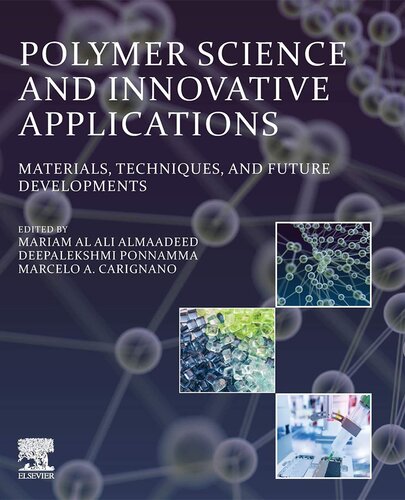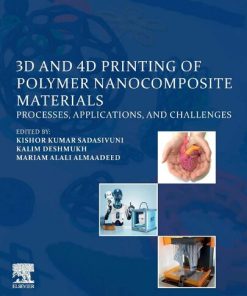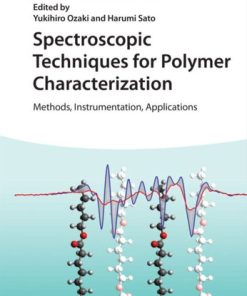Polymer science and innovative applications materials, techniques, and future developments 1st edition by Deepalekshmi Ponnamma 0128173039 9780128173039
$50.00 Original price was: $50.00.$25.00Current price is: $25.00.
Polymer science and innovative applications materials, techniques, and future developments 1st edition by Deepalekshmi Ponnamma – Ebook PDF Instant Download/DeliveryISBN: 0128173039, 9780128173039
Full download Polymer science and innovative applications materials, techniques, and future developments 1st edition after payment.

Product details:
ISBN-10 : 0128173039
ISBN-13 : 9780128173039
Author : Deepalekshmi Ponnamma
Polymer Science and Innovative Applications: Materials, Techniques, and Future Developments introduces the science of innovative polymers and composites, their analysis via experimental techniques and simulation, and their utilization in a variety of application areas. This approach helps to unlock the potential of new materials for product design and other uses. The book also examines the role that these applications play in the human world, from pollution and health impacts, to their potential to make a positive contribution in areas including environmental remediation, medicine and healthcare, and renewable energy. Advantages, disadvantages, possibilities, and challenges relating to the utilization of polymers in human society are included.
Polymer science and innovative applications materials, techniques, and future developments 1st Table of contents:
1 Polymers to improve the world and lifestyle: physical, mechanical, and chemical needs
1.1 Introduction
1.2 Industrial revolutions and polymer applications
1.3 Polymers: general classification and production
1.3.1 Fabrication methods
1.3.2 Classification of polymers
1.3.2.1 Thermoplastics
1.3.2.2 Thermosets
1.3.2.3 Elastomers (rubbers)
1.4 Current lifestyle and the need of polymers
1.5 Polymers to composites
1.6 Specific requirements of polymers using physical, mechanical, and chemical methods
1.7 Internet of Things and smart materials
1.8 Conclusions
Acknowledgments
References
2 Morphology analysis
2.1 Introduction
2.2 Polymer morphology
2.2.1 Crystalline polymers
2.2.2 Amorphous polymers
2.2.3 Semicrystalline polymers
2.2.4 Polymer blends
2.2.5 Polymer composites
2.3 Characterization methods
2.3.1 Indirect observation methods
2.3.1.1 X-ray diffraction
2.3.1.2 Small angle light scattering
2.3.1.3 Small angle X-ray scattering
2.3.1.4 Differential scanning calorimetry
2.3.1.5 Dynamic mechanical analysis
2.3.2 Direct observation methods
2.3.2.1 Optical microscopy
2.3.2.2 Scanning electron microscopy
2.3.2.3 Transmission electron microscopy
2.3.2.4 Scanning tunneling microscopy
2.3.2.5 Atomic force microscopy
2.4 Applications
2.5 Conclusion
Acknowledgments
References
3 Chemical analysis of polymers
3.1 Introduction
3.2 Molecular weight determination
3.2.1 Determination of molecular weight by end group analysis
3.2.1.1 Chemical analysis of amine, carboxyl and hydroxyl groups
3.2.2 Determination of number average molecular weight by end group analysis
3.3 Infrared spectroscopy
3.3.1 Infrared analysis of saturated polymers
3.3.2 Infrared analysis of polymers containing unsaturation
3.3.3 Infrared analysis of polymers containing aromatic group
3.3.4 Infrared analysis of polymers containing hydroxyl group
3.3.5 Infrared analysis of polymers containing ester group
3.3.6 Infrared analysis of polymers containing carboxylic acid group
3.3.7 Infrared analysis of polymers containing amide group
3.4 Nuclear magnetic resonance spectroscopy
3.4.1 Nuclear Zeeman splitting
3.4.2 Chemical shift
3.4.3 Spin–spin coupling
3.4.4 Analysis of end groups by 1H nuclear magnetic resonance spectroscopy
3.4.5 Determination of molecular weight by 1H nuclear magnetic resonance spectroscopy
3.4.6 Copolymer analysis by 1H nuclear magnetic resonance spectroscopy
3.5 Mass spectrometry
3.5.1 Electrospray ionization mass spectrometry
3.5.2 Matrix-assisted laser desorption/ionization mass spectrometry
3.5.3 Applications of electrospray ionization and matrix-assisted laser desorption/ionization spectr
3.6 Conclusion
Acknowledgments
References
4 Mechanical analysis of polymers
4.1 Introduction
4.2 Mechanical properties of polymers
4.2.1 Stress–strain behavior
4.2.2 Viscoelasticity
4.2.3 Time–temperature dependence
4.2.4 Tensile strength
4.2.5 Flexural modulus (modulus of elasticity)
4.2.6 Elongation at break
4.2.7 Crazing and shear yielding
4.2.8 Fracture and fracture mechanics
4.2.9 Coefficient of friction
4.2.10 Fatigue and fatigue crack propagation
4.2.11 Toughness
4.2.12 Abrasion resistance
4.3 Dynamic mechanical thermal analysis of polymers
4.4 Factors affecting the mechanical properties of polymers
4.4.1 Molecular weight
4.4.2 Degree of crystallinity
4.4.3 Temperature
4.4.4 Processing methods
4.5 Conclusion
References
5 Physical and thermal analysis of polymer
5.1 Introduction
Techniques used for physical and thermal analysis of polymers
5.1.1 Infrared and Raman spectroscopy
5.1.1.1 Basic principle
5.1.1.2 Applications
5.1.2 Nuclear magnetic resonance spectroscopy
5.1.2.1 Basic principle
5.1.2.2 Applications
5.1.3 X-ray analysis
5.1.3.1 Basic principle
5.1.3.2 Applications
5.1.4 Scanning electron microscopy and transmission electron microscopy
5.1.4.1 Basic principle
5.1.4.2 Applications
5.1.5 Thermogravimetry and differential scanning calorimetry
5.1.5.1 Basic principle
5.1.5.2 Applications
5.1.5.2.1 Thermogravimetry applications
5.1.5.2.2 Differential thermal analysis and differential scanning calorimetry applications
5.1.6 Quantum chemical calculations
5.1.6.1 Basic principle
5.1.6.2 Applications
5.1.7 Gas permeation behavior
5.2 Conclusion
Acknowledgment
References
6 Theoretical simulation approaches to polymer research
6.1 Introduction
6.2 Methodologies and applications
6.2.1 Molecular dynamics simulations
6.2.2 Dissipative particle dynamics simulations
6.2.3 Molecular theory
6.3 Conclusion
References
7 An example of theoretical approaches in polymer hydrogels: insights into the behavior of pH-respon
7.1 Introduction
7.2 Acid–base equilibrium in dilute solutions: ideal behavior
7.3 Protonation of weak polyacid hydrogel films
7.3.1 Local pH
7.3.2 Displacement of chemical equilibrium: the role of salt concentration
7.4 Histidine-tag adsorption to pH-responsive hydrogels
7.4.1 Adsorption is a nonmonotonic function of pH
7.4.2 Adsorption can modify the pH inside the hydrogel
7.5 Adsorption of proteins to pH-sensitive hydrogels
7.5.1 Protein model and solution titration curves
7.5.2 The role of pH and salt concentration in the magnitude of adsorption
7.5.3 Protein charge regulation
7.5.4 Protonation of amino acids after adsorption
7.5.5 Adsorption from binary protein mixtures
7.6 Conclusion
Acknowledgment
References
8 Pectin as oral colon-specific nano- and microparticulate drug carriers
8.1 Introduction
8.1.1 Synthetic polymers
8.1.2 Natural polymer
8.2 Pectin as bioactive dietary fiber
8.2.1 Prebiotic
8.2.2 Antibacterial
8.2.3 Antioxidant
8.2.4 Antidiabetic
8.2.5 Antitumor
8.3 Pectin-based oral drug delivery system
8.3.1 Tablet
8.3.2 Beads
8.3.3 Pellets
8.3.4 Nanoparticles
8.4 Oral colon-specific drug delivery mechanism
8.5 Conclusion
References
9 Starch as oral colon-specific nano- and microparticulate drug carriers
9.1 Introduction
9.2 Polysaccharides as anticancer drug carriers
9.3 Colon anatomy and physiology
9.4 Colon cancer
9.4.1 Colon cancer statistics
9.4.2 Treatment modes, their disadvantages, and limitations
9.5 Colon-specific drug delivery
9.6 Starch as a drug carrier
9.6.1 Physicochemical properties of starch
9.6.2 Resistant starch
9.6.3 Preparations of resistant starch
9.6.3.1 Acetylation
9.6.3.2 Acid hydrolysis
9.6.3.3 Amylose–lipid complexation
9.6.3.4 Crosslinking
9.6.3.5 Enzymatic debranching
9.6.3.6 Hydrothermal treatment
9.6.4 Pharmaceutical applications of starch
9.6.5 Starch as oral colon-specific drug carrier
9.6.5.1 Beads
9.6.5.2 Hydrogels
9.6.5.3 Microparticles
9.6.5.4 Nanoparticles
9.6.5.5 Pellets
9.7 Conclusion
Acknowledgment
References
10 Polymers in textiles
10.1 Introduction
10.2 Brief history of manmade fibers
10.3 Terminology and definitions
10.4 Fiber manufacturing
10.4.1 Melt spinning
10.4.2 Dry spinning
10.4.3 Wet spinning
10.4.4 Gel spinning
10.4.5 Nonwovens processing
10.5 Characterization and testing of textile fibers
10.5.1 Density
10.5.2 Mechanical properties
10.5.2.1 Tenacity
10.5.2.2 Elongation to break
10.5.3 Fiber structure and morphology
10.5.4 Fiber identification
10.5.4.1 Microscopy test
10.5.4.2 Chemical test
10.5.4.3 Burn test
10.5.4.4 Density test
10.5.4.5 Stain test
10.5.5 Other characterization and identification techniques
10.6 Polymers in textiles: major manmade fibers
10.6.1 Polyester
10.6.1.1 Chemistry
10.6.1.2 Properties
10.6.1.3 Uses
10.6.2 Nylon
10.6.2.1 Chemistry
10.6.2.2 Properties
10.6.2.3 Uses
10.6.3 Acetate fiber
10.6.3.1 Chemistry
10.6.3.2 Properties
10.6.3.3 Uses
10.6.4 Acrylic fiber
10.6.4.1 Chemistry
10.6.4.2 Properties
10.6.4.3 Uses
10.6.5 Modacrylic fiber
10.6.5.1 Chemistry
10.6.5.2 Properties
10.6.5.3 Uses
10.6.6 Spandex fiber
10.6.6.1 Chemistry
10.6.6.2 Properties
10.6.6.3 Uses
10.6.7 High-performance fibers
10.6.7.1 Aramids (Nomex and Kevlar)
10.6.7.1.1 Chemistry
10.6.7.1.2 Properties
10.6.7.1.3 Uses
10.6.7.2 Ultrahigh molecular weight polyethylene
10.6.7.2.1 Chemistry
10.6.7.2.2 Properties
10.6.7.2.3 Uses
10.6.7.3 Carbon fiber
10.6.7.3.1 Chemistry
10.6.7.3.2 Properties
10.6.7.3.3 Uses
10.6.8 Polyolefins
10.6.8.1 Chemistry
10.6.8.2 Properties
10.6.8.3 Uses
10.7 Conclusion
References
11 Polymers in electronics
11.1 Introduction
11.2 Type of polymers
11.2.1 Conducting polymers
11.2.1.1 Traditional sequences of conducting polymer
11.2.1.2 Features of conducting polymers
11.2.1.3 Structure of conducting polymers
11.2.1.4 Advantages of conducting polymers
11.2.2 Semiconducting polymers
11.2.2.1 Filled polymers
11.2.2.2 Ionic polymers or ionomers
11.2.2.3 Charge transfer polymers
11.2.2.4 Conjugated conducting polymers
11.2.2.4.1 Charge transport polymer
11.3 Applications of semiconducting polymers
11.3.1 Fuel cells
11.3.2 Piezoelectric materials
11.3.3 Optoelectronics
11.3.4 Flexible electronics
11.3.5 Printable electronics
11.3.6 Dielectrics
11.3.7 Sensors
11.3.7.1 Temperature sensors
11.3.7.2 pH sensors
11.3.7.3 Gas sensors
11.3.7.4 Ion-selective sensors
11.3.7.5 Stress sensors
11.3.7.6 Biosensors
11.3.7.7 Multisensors
11.4 Conclusion
Acknowledgment
References
12 Polymers in robotics
12.1 Introduction
12.1.1 Robotics: the term, the idea
12.1.2 History of robots
12.1.3 Classification of robots
12.1.3.1 Degrees of freedom
12.1.3.2 Kinematic structure
12.1.3.3 Drive technology
12.1.3.4 Workspace geometry
12.1.3.5 Motion characteristics
12.1.3.6 Applications
12.1.4 Components of robots
12.1.4.1 Mechanical platform
12.1.4.2 Sensors
12.1.4.3 Motors
12.1.4.4 Power supply
12.1.4.5 Electronic controls
12.1.4.6 Microcontroller systems
12.1.4.7 Languages
12.1.4.8 Pneumatics
12.1.4.9 Driving high-current loads from logic controllers
12.2 Role of polymers in robotics
12.2.1 Types of polymers used in robotics
12.2.1.1 Electroactive materials
12.2.1.1.1 Mechanism of electroactive polymers
12.2.1.2 Electronic electroactive polymers
12.2.1.2.1 Piezoelectric polymers
12.2.1.2.2 Electro-strictive polymers
12.2.1.2.3 Dielectric elastomeric actuators
12.2.1.2.4 Liquid crystal elastomers
12.2.1.2.5 Ferroelectric polymers
12.2.1.3 Ionic electroactive polymers
12.2.1.3.1 Ionic polymer–metal composites
12.2.1.3.2 Carbon nanotubes
12.2.1.3.3 Ionic polymer gels
12.2.1.3.4 Conductive polymers
12.2.1.3.5 Electrorheological fluids
12.2.1.4 Thermoplastics in robotics
12.2.1.5 Epoxy-based materials in robotics
12.2.2 Composites in robotics
12.2.3 Polymeric sensors
12.3 Applications of robotics
12.3.1 Terrestrial applications
12.3.2 Medical sector
12.3.3 Industrial sector
12.3.4 Miscellaneous applications
12.3.5 Space applications
12.3.6 Underwater applications
12.3.7 Military applications
12.3.8 In mining
12.4 Conclusion
References
13 Polymers in optics
13.1 Introduction
13.2 Properties of optical polymers
13.2.1 Refractive index
13.2.2 Abbe number (V number)
13.2.3 Birefringence
13.2.4 Transparency
13.2.5 Color
13.2.6 Gloss
13.3 Characterization of optical properties of polymers
13.3.1 Abbe refractometer
13.3.2 UV–visible absorption spectroscopy
13.3.3 Photoluminescence spectroscopy
13.3.4 Raman spectroscopy
13.3.5 Brillouin spectroscopy
13.4 Polymer optics: the manufacturing technology
13.5 Applications of polymers in optics
13.5.1 Polymers in fiber optics
13.5.2 Polymers in optical lenses
13.5.3 Polymers in lasers
13.5.4 Polymers in optical sensors
13.5.5 Polymers in waveguide fabrication
13.5.6 Polymers in nonlinear optics
13.5.7 Polymers in solar cells
13.5.8 Polymers in photocatalysis
13.5.9 Polymer optics in the biomedical field
13.6 Future perspective and challenges in polymer optics
13.7 Conclusion
Acknowledgments
References
14 Polymers in space exploration and commercialization
14.1 Introduction
14.2 Space environments, actions, and conditions
14.3 Effect of space environment on polymers
14.3.1 Vacuum
14.3.2 Thermal cycling
14.3.3 Atomic oxygen
14.3.4 Ionizing radiation
14.3.5 Solar ultraviolet radiation
14.4 Use of inorganic polymers as building materials
14.5 Space resources
14.5.1 Materials from space resources
14.6 Use of polymers in space
14.6.1 Inflatable bases
14.6.2 Construction materials
14.6.2.1 Polymer concrete
14.6.2.2 Geopolymer concrete
14.6.2.3 Advanced polymer-based materials
14.7 Research needs and future directions
14.7.1 Utilizing robotics
14.7.2 Processing and printing of polymers in space
14.7.3 Flexible and energy harvesting polymers
14.8 Novel polymers
14.9 Conclusion
References
15 Polymers in sports
15.1 Introduction
15.2 Materials used in sports
15.3 Evolution of materials used in sports from traditional to composites
15.3.1 Wood
15.3.2 Metals
15.3.3 Composite materials
15.4 Common polymers in sports
15.4.1 Cyanoacrylate
15.4.2 Vectran
15.4.3 Gutta-percha
15.4.4 trans-1,4-Polyisoprene
15.4.5 Surlyn copolymer
15.4.6 Polycarbonate
15.4.7 Epoxy resin
15.4.8 Polyurethane
15.4.9 Acrylonitrile–butadiene–styrene
15.4.10 Polyvinyl chloride
15.4.11 Poly(ethylene-vinyl acetate)
15.4.12 Carbon fiber–reinforced polymer
15.4.13 Soft and hard polyethene
15.4.14 Polymeric foams
15.4.15 Neoprene
15.4.16 Polydimethylsiloxane
15.4.17 Nylon
15.4.18 Polyamides
15.4.19 Polyolefins
15.5 Polymers in winter sports
15.5.1 Skiing
15.5.2 Ice hockey
15.6 Polymeric sports surfaces
15.7 Polymers in sports protection equipment
15.7.1 Protection for the mouth
15.7.2 Protection for the head
15.7.3 Protection for the shoulders
15.7.4 Protection for the hands
15.8 Polymers in tennis
15.8.1 Nylon string
15.8.2 Polyester string
15.8.3 Kevlar string
15.8.4 Natural gut string
15.9 Polymers in athletics and gymnastics
15.10 Polymers in golf
15.11 Polymers in pole vaulting
15.12 Polymers in water sports
15.13 Polymers in motor sports
15.14 Polymers in cycling
15.15 Polymers in sportswear
15.15.1 Thermal properties of sportswear
15.15.2 Golf attire
15.16 Polymers in sports footwear
15.17 Conclusion
References
16 Polymers and food packaging
16.1 Introduction
16.2 Food packaging
16.3 Packaging materials
16.3.1 Polymers
16.3.2 Biodegradable polymers
16.3.3 Synthetic polymers and biopolymers hybrids
16.3.4 Nanomaterials
16.4 Some methods for biopolymers production
16.5 Biopolymers and active packaging
16.6 Conclusion
References
17 Polymers in cosmetics
17.1 Introduction
17.2 Understanding polymer/surfactant interactions
17.3 Use of polymers in cosmetics
17.3.1 Synthetic polymers
17.3.1.1 Thickening by chain entanglement
17.3.1.2 Thickening by covalent cross-linking
17.3.1.3 Thickening by an associative mechanism
17.3.2 Polysaccharide-based polymers
17.3.2.1 Anionic polysaccharides
17.3.2.2 Cationic polysaccharides
17.3.2.3 Nonionic polysaccharides
17.3.2.4 Amphoteric polysaccharides
17.3.3 Proteins
17.3.3.1 Proteins in skin care
17.3.3.2 Proteins in hair care
17.3.3.3 Proteins in cleansing products
17.3.4 Silicones
17.3.4.1 Cyclomethicones
17.3.4.2 Dimethicone
17.3.4.3 Amodimethicone
17.3.4.4 Alkyl-modified silicones
17.3.5 Examples and case studies
17.3.5.1 Lather enhancer cellulose in personal care
17.3.5.2 Polymers in hair care
17.3.5.3 Application of acetylene-derived polymers for personal care
17.3.5.4 Cosmetic use of chitin and chitosan
17.4 Conclusion
References
Further reading
18 Polymers in food
18.1 Introduction
18.2 Classification of food polymers
18.2.1 Polysaccharides
18.2.1.1 Food storage polysaccharides
18.2.1.2 Structural polysaccharides
18.2.1.3 Mucosubstances
18.2.2 Polypeptides
18.2.3 Lipids
18.2.4 Synthetic and composite food polymers
18.3 Conclusion
References
Further reading
19 Future needs and trends: influence of polymers on the environment
19.1 Introduction
19.1.1 The structure and properties of polymers
19.1.1.1 The structure of polymers
19.1.1.2 Molecular arrangement of polymers
19.1.1.3 Characteristics of polymers
19.1.1.4 Mechanical and thermal stabilities of polymers
19.1.2 Inspiration of polymers in daily life
19.1.3 Polymer uses in modern life
19.2 Polymers in the environment
19.2.1 Polymers and their impacts in society: a general view
19.2.2 Overview of environmental and societal applications of polymers
19.2.2.1 Polypropylene
19.2.2.2 Polyurethane
19.2.2.3 Polyvinyl chloride
19.2.2.4 Acrylonitrile butadiene
19.2.2.5 Polyamide
19.3 Polymer-based materials as a new direction for environmental remediations
19.3.1 Carbon-based polymeric composite materials for CO2 capture
19.3.2 Polymer-based membranes
19.3.3 Magnetic polymer composites
19.3.4 Ionic liquid based polymeric composites
19.4 Polymer-based materials for societal applications
19.4.1 Polymers-based materials for agriculture and horticulture
19.4.2 Polymer-based materials for packaging materials
19.4.3 Polymeric materials for hydrogen storage purpose
19.4.4 Polymer-based materials for corrosion control
19.4.5 Polymer-based materials for medical and biomedical applications
19.5 Polymers: recent trends, strategic changes, economic and market demands
19.5.1 Economic development of polymeric products
19.6 Polymers: future impacts on energy and solar cells
19.7 Consequences of the nonbiodegradable polymers derived from renewable resources
19.8 Recyclability, biodegradability, and reusability of polymeric products
19.9 Polymeric products disposal ways and its impacts
19.10 Waste to wealth future perspectives of ecofriendly polymer materials development and usage
19.11 Conclusion
People also search for Polymer science and innovative applications materials, techniques, and future developments 1st:
what is polymer science and technology
polymer science jobs
current trends in polymer science
polymer science indiana
polymer science and engineering
Tags: Polymer science, innovative applications, materials, techniques, future developments, Deepalekshmi Ponnamma
You may also like…
Engineering - Industrial Engineering & Materials Science
Housekeeping & Leisure - Interior Design & Decoration
Engineering
Chemistry - Analytical Chemistry












